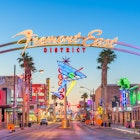

twilight on the riverfront in Augusta Georgia
Visiting Augusta, Georgia, has long been the holy grail for golf fanatics, thanks to the world-famous Masters Tournament that kicked off here in 1934. But today’s Augusta – Georgia's second most populous city – has plenty to offer visitors beyond the glorious green of the Augusta National Golf Course.
Here are seven exciting things to check out in this rapidly rising city.

Walk in the footsteps of James Brown
The inimitable James Brown – the Godfather of Soul himself – grew up in Augusta in the 1930s. It wasn’t an easy childhood, but eventually his musical talent lifted him out of poverty and made him an international star. The rest, as they say, is history. The Augusta Museum of History has the world’s most comprehensive James Brown exhibit, with thousands of personal items including his jazzy capes. His daughters spearheaded the James Brown Family Historical Tour, taking you down memory lane throughout town, including the house where he grew up (a brothel run by his aunt); his life-size statue on Broad Street (he was rather petite); the Imperial Theatre, where he rehearsed; and Deshawn’s Seafood, run by his son-in-law, who might be induced to tell a tale or two. There’s even a street named after him: Ninth Street became James Brown Boulevard in 1993.

A revitalized Broad Street
For years, Augusta’s main street faltered through hard times. But in the 1990s, the artistic community began to settle into into Broad Street, adding vitality with galleries, murals and creative spirit. Restaurants and other businesses followed, renovating the mélange of architecturally significant buildings (ranging from Federal to Greek Revival to Art Deco and International in style) and bringing life to the street. Today, more than 150 of these buildings have been placed on the National Register, including the recently reopened arte moderne Miller Theater, the official home of the Symphony Orchestra Augusta. For the food-minded, innovative eateries include Farmhaus Burger, Nacho Mama’s, Mellow Mushroom and Whiskey Bar Kitchen. The artists are still around, working in studios and purveying their wares, including fine art, pottery and hand-crafted glass.

Strolling the Riverwalk
There’s something about being near the water that draws people, and in Augusta’s case, the waterfront draw is the languorous Savannah River. In the hot summer months, locals seek refuge along the Riverwalk, a brick, tree-shaded walkway winding along the river between 6th and 10th Streets. Highlights include the miniature, waterfall-graced Japanese Gardens and the 1,800-seat Jessye Norman Amphitheater, where eclectic concerts entertain in summer. The popular Saturday farmer’s market (open March through November) unfurls onto the 8th Street Plaza and always includes live music and local seasonal farm goods.
A Georgia peach of a beer
Everyone’s making craft beer these days, it seems. But not everyone comes from the Peach State and thinks of incorporating the sweet nectar into its brew. At River Watch Brewery – a mother-daughter enterprise and the first post-Prohibition brewery to open in Augusta – peach is used to flavor its seasonal ‘Peach 3 Under Par.’ The result is not overwhelming; just a genteel hint of southern yumminess. If it’s not on tap, there are plenty of other tempting brews to try.

Decadent pimento cheese
This novelty ‘food,’ a creamy concoction of cheddar cheese, mayonnaise and pimentos, is the go-to comfort food throughout the South, but in Augusta, it’s a special source of pride – pimento cheese is the signature sandwich at the Masters Tournament (on sale at the bargain price of $1.50). Year-round, chefs around town have come up with modern, unique ways to serve it. Whiskey Bar Kitchen uses it to top its juicy burger, Farmhaus slathers it on a sandwich with pork belly and bacon jam, Craft & Vine has distilled it into a luscious fondue, and WifeSaver has been serving it the old-fashioned way – as a side – since 1965.
Cruising the Augusta Canal
The Augusta Canal carried the city through the Civil War and contributed to the region’s late-19th-century industrial boom. But by the 1950s, as textile mills began to close, the canal was all but forgotten. At one point, city officials even considered replacing it with a superhighway. Thank goodness that all changed in the mid-1970s, as locals realized the canal’s historic and scenic potential and set about preserving it. Today the Augusta Canal offers a tranquil escape for kayakers, birdwatchers and anglers, with runners, bikers and walkers taking to the adjacent towpath. But the best thing to do is take a canal boat tour up and down its length, listening to a fascinating narrative of its history and natural wildlife. You’ll see the Confederate Powder Works, two of Georgia’s only remaining 18th-century houses, plenty of turtles and maybe even an alligator along the way. On some summer evenings the boat trip features live music, an idyllic way to enjoy a picnic dinner. The Augusta Canal Discovery Center, located in an old textile mill, provides historical insights.

Porch-sitting in Summerville
When summers became stifling, wealthy Augustans historically escaped to Summerville, a hilltop neighborhood filled with gorgeous Southern mansions. Most of the houses are private, though the Greek Revival-style Appleby Library and the Stephen Vincent Benét House are open for tours. The best place for a taste of yesteryear, however, is the grandiose 1910 Partridge Inn, originally the site of George Walton’s home (one of Georgia’s three signers of the Declaration of Independence). The open veranda is the perfect place to sip a cocktail and soak up the Georgia sunshine.
Explore related stories






 Destination PracticalitiesThe best time to go to Italy: plan your trip with our seasonal guide
Destination PracticalitiesThe best time to go to Italy: plan your trip with our seasonal guideDec 3, 2024 • 7 min read

 Tips & AdviceThe 15 best places to visit in Italy, from Venice to the Cinque Terre
Tips & AdviceThe 15 best places to visit in Italy, from Venice to the Cinque TerreDec 3, 2024 • 11 min read










